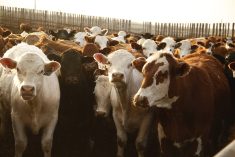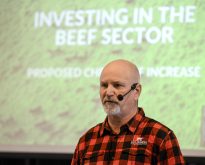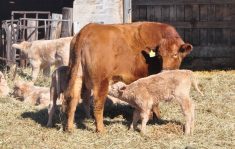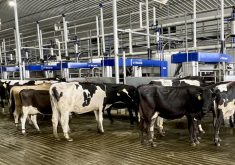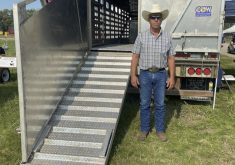Dr. Jordan Thomas says knowing which cows to cull in a cow-calf operation, and when, can increase profitability and improve productivity.
“We’re all businesses, and I think that’s a really important point that often gets overlooked in producer meetings like this one,” said Thomas. “We are really trying to generate a positive return on assets. Which is challenging … (when) we’re facing ever-increasing annual costs.”
Why it matters: There are ways to cut costs on cow-calf operations, but first question whether each cow is making money.
Read Also
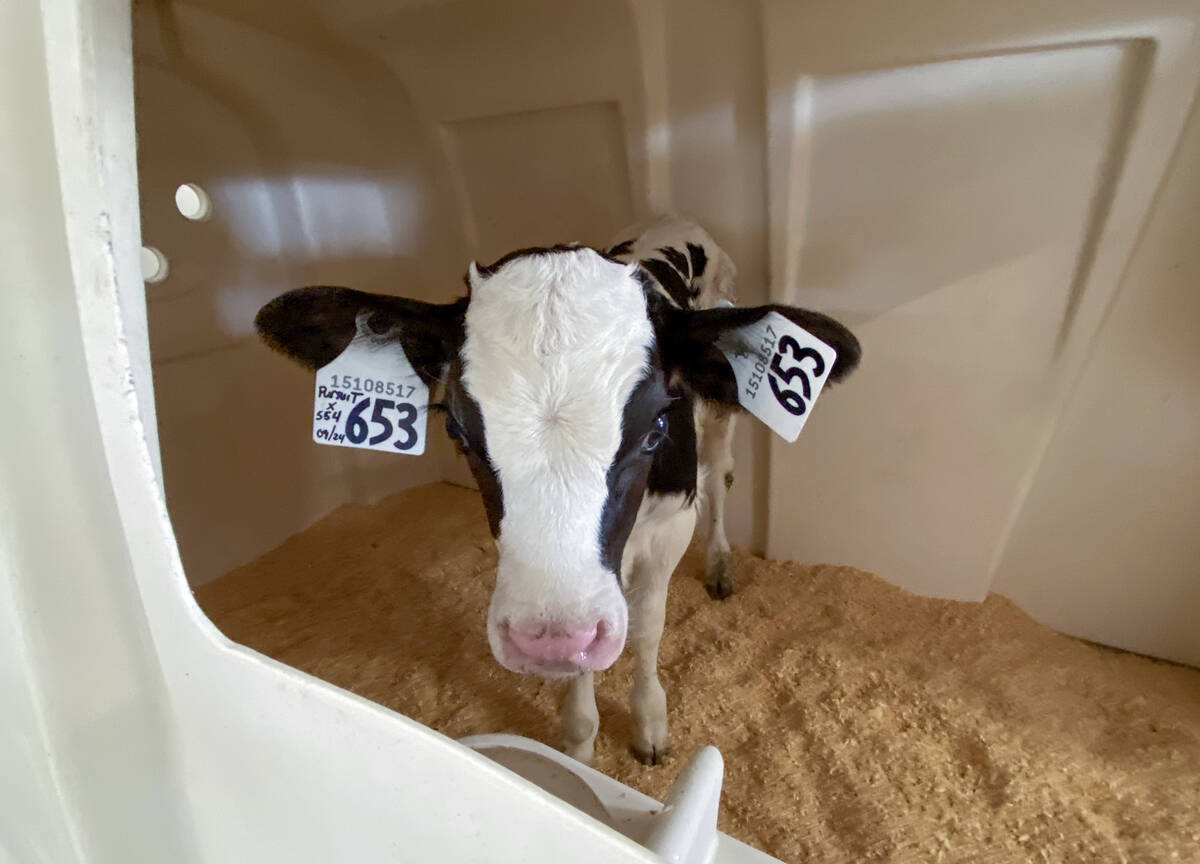
Lactanet turns methane expertise into business opportunity
Lactanet’s new fee-for-service breeding tool initiative to reduce greenhouse gas emissions in Canadian and Swiss Holstein herds will launch in April 2026.
The University of Missouri state beef reproduction specialist shared his insight on the “silent killer” of cow-calf profitability at the Grey Bruce Farmers’ Week Beef Day.
“Remember that livestock comes from two words, not one word. It’s live, stock, OK?” said Thomas. “It’s stocks, investments, assets — they just happen to be alive.”
Despite the feeder calf market projected to be strong into 2023, additional costs will eat potential margins, he said, but using ratios like per-cow income over operating cost and income over total costs will help determine cow depreciation.
He pointed to the 2023 Northern Missouri beef cow-calf income over operating costs planning budget for fall calving. The per cow income over operating costs was -$206, and the income over total costs sat at -$395.
“A fundamental truth, from a business perspective, is when cows are losing money on an individual animal basis, particularly when that top line is also negative, scale does not do very much for us,” Thomas said.
“We’re just scaling up a business that doesn’t actually have a profit margin in any of the products it produces.”
Thinking beyond typical industry practices
A commercial cow-calf producer could assess feed, stored feed and forage costs as the most accessible area to cut. While that could help, it could also deplete revenue by preventing a cow from reaching its optimal performance. Reducing costs and reaching optimal performance requires a more thoughtful approach.
A better approach is to think about the cause of the costs, said Thomas.
“For example, in that -$400 range in this budget, the real question I should be asking is, why. Why is my feed and stored forage budget so high?”
He compared the number of days of hay fed in Minnesota, Missouri and Mississippi and found they are similar in length and calving season. It forced him to question the reason for having long hay-feeding seasons, high winter feed costs, long calving seasons and potentially reduced productivity.
Could those costs be better managed by looking at the expense of cow replacement, which is the second highest cost of production?
Thomas said it’s not unusual for producers to delay marketing cull cows due to perceived overvalue.
“Doesn’t that sound like later bred cows, or later bred heifers, or cows that failed to conceive in the breeding season that we want them to conceive in?” Thomas said.
“We are so tempted to make some kind of decision by rolling those animals into another breeding season, or whatever it is, choosing not to market them — because we overvalued them.”
Early breeding cows are more efficient
Using the example of a 60-day breeding and a 60-day calving season, Thomas explained how annual cow depreciation costs are calculated based on early conception.
Those who catch and calve within the first day of breeding and calving seasons take full advantage of the 82-day break to cycle through a natural period of suppressed reproductive functionality and cycle around the first day of the next breeding season.
Cows that catch and calve at the end of the 60-day breeding and calving seasons hit the first day of the next breeding season in the non-cycling postpartum estrus, incapable of becoming pregnant on the first day and disproportionately likely to be open at the end he said.
“Because she only has cyclicity for the later portion breeds if she does cycle at all, she may only have one opportunity to conceive in a 60-day breeding season,” Thomas said. “That is a substantially different weaning weight produced by that calf and cow in the next year, and so a substantially different amount in revenue.”
Early breeding cows consistently wean heavier calves through their first six years, while a late-breeding cow produces and weans fewer and lighter calves over its lifetime.
“Start to be really radical about your replacement heifer selection if you’re a commercial producer,” advised Thomas. “That pounds of calf weaned is really what you get paid on.”
Basing heifer replacement selection on early conception will generate the best return on assets.
“To get the number of heifers that conceive early, we often need to develop a larger proportion of our heifer calf crop,” Thomas said, far more than the 15-to-18 per 100 usually selected.
He suggested producers consider heifers as a “prospective replacement candidate” instead of a “replacement” until after they’ve preg-checked as early conceivers.
Cow-calf producers invest in two different but overlapping enterprises, he said. On one side is the cow-calf operation and on the other is heifer development. The cow-calf side sells weaned heifer calves to the heifer development operation, which in turn sells replacement heifers back to the cow-calf.
“You’re both the buyer and the seller in that transaction, and that’s always really tough, so don’t sell yourself these poorly profitable, late-conceiving replacement heifers because you happen to be the seller and not just the buyer.”
Thomas has five rules to assess culling versus marketing cows.
First is remembering you buy every cow, because the decision not to sell something, from a balance sheet perspective, is deciding to reinvest or rebuy it.
Strategically marketing cows likely not to conceive in the following breeding season and investing the equity into early cyclers who will consistently provide a heavier calf at weaning is worth culling early.
“That early conceiving animal that we replaced (the culled cow) with will also be more likely to hold her value and be bred back next season,” said Thomas.
He added that cows who calve early in the season wean larger calves than late-season calves.
“A modern beef calf will often gain about two pounds a day from birth to weaning. So, a 60-day difference in calf age can easily be 120 pounds,” Thomas said.
From a heifer longevity perspective, heifers that calved during the first 21-day period with their first calf remained in the herd longer than heifers who calved later.
Between 70 and 80 per cent of those early-calving heifers bred back successfully for a second calf, while late-calving heifers achieved 65 per cent, and by year three, the divide increased.
“The real cost is the difference between cow replacement costs and cull cow sales. It’s that marginal difference we need to be controlling,” said Thomas. “It’s not necessarily only this cost of cow replacement.”
In the U.S., a weaned heifer that is bred sees a sharp increase in market appreciation value and two-year-old bred heifers that successfully breed back see another rise in appreciation. Strong performance throughout years three to five shows value retention before rapidly depreciating in years six to eight, after which lower value levels stabilize due to age.
However, a two-year-old that failed to breed back and is too old to enter the premium quality beef chain has a much lower value, and a three-to-five-year-old open cow’s value is half of its bred-back counterpart.
“It’s a tremendous value difference that we lose in that production cycle simply by failing to get those cows bred back, or failing to market those cows as bred cows rather than open cows,” said Thomas.







